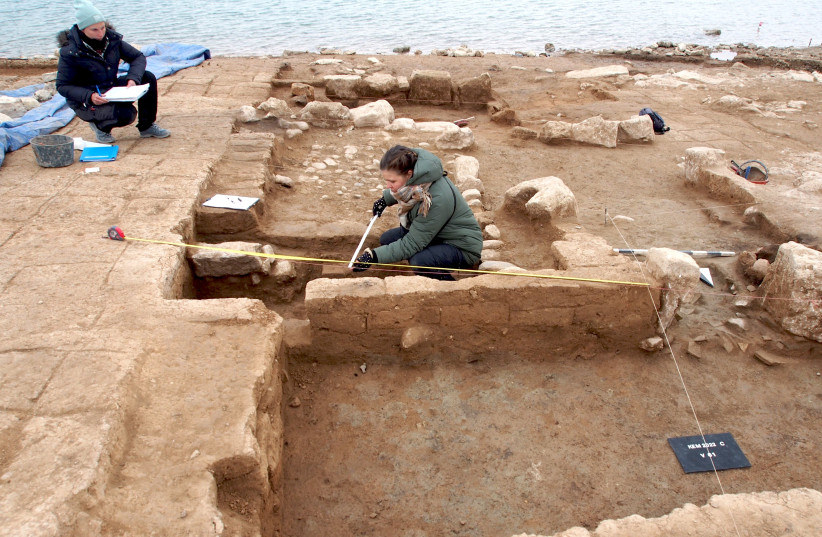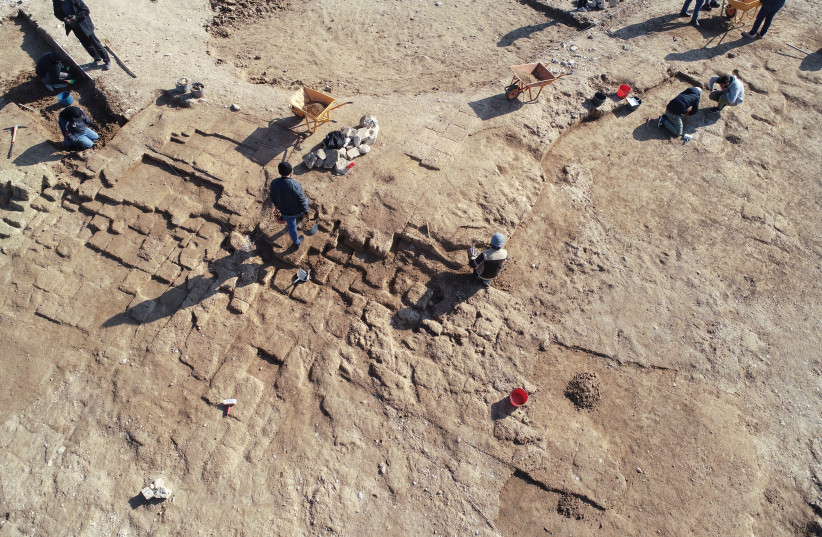Sometimes, as the saying goes, every cloud has its silver lining. And even though the skies in southern Iraq have been empty of crucial rain clouds for several months in one of its worst droughts, one could say that a silver lining has appeared down on the ground.
The drought has allowed a group of Kurdish and German archaeologists to briefly resume excavations of an ancient city that had been previously submerged under the waters of the Mosul Dam reservoir in Kemune.
According to a press release from the University of Freiburg in Germany, the ruins of the extensive city complex including a palace and several large buildings, which emerged when the waters of the reservoir receded.
Iraq is one of the countries most affected by climate change and its south has been suffering from an extended drought for several months. In December, large amounts of water were drained from the Mosul reservoir to allow farmers to irrigate their fields and thus not lose their crops.
Researchers believe the city could be ancient Zachiku, an important center in the Mittani Empire. The Mittani Empire, which flourished 3,400 years ago around 1550-1350 BC, was centered in northern Mesopotamia, encompassing the region of modern-day Turkey, Syria and Iraq.

Archaeologists had worked at the site in 2018 during a previous drought; the current draining of the reservoir presented them another opportunity to continue their work, but they had to move quickly to uncover and document additional sections of the city before it was once again submerged in water.
A race against time
Kurdish archaeologist Dr. Hasan A. Qasim, director of the Kurdistan Archaeology Organization (KAO), German archaeologists Assistant Professor Dr. Ivana Puljiz from the University of Freiburg and Prof. Dr. Peter Pfalzner from the University of Tubingen worked quickly to put together a joint rescue excavation in cooperation with the Department of Antiquities in Dohuk, said the press release.
They put together a team in two days, raised funds under short notice from the Frintz Thyssen Foundation via the University of Freiburg and, within two weeks, they were on the ground in Kemune, Iraq. They worked non-stop in all kinds of weather conditions, including snow, rain, fog, hail and storms in January and February 2022. They worked in a race against time, not knowing when the waters in the reservoir would begin to rise again.
Within a short time, the researchers were able to largely reconstruct the plan of the city, according to the press release. In addition to the palace which had already been documented in a short campaign in 2018, several other large buildings were uncovered in the sprawling city complex – including a massive fortification with a wall and towers, a monumental, multi-story warehouse building and an industrial compound.
“The huge warehouse building is of particular importance, because it must have stored enormous amounts of goods that were probably brought in from all over the region,” said Puljiz, in the press release.
The Mitanni kingdom
Mitanni was one of several kingdoms and small states founded by the Indo-Iranians in Mesopotamia and Syria. For a long time, they vied with Egypt for control of the area of modern-day Syria, eventually establishing amicable relations with the southern kingdom. King Saustatar, who reigned from 1500-1450 BC, is considered the most outstanding Mitannian ruler and is said to have looted the Assyrian palace. The Mitanni kingdom came to an end under King Tushratta, under whose reign their capital city of Wassukkani was destroyed by the Hittites. Tushratta was assassinated in 1360 BC, and after becoming part of the Hittite Empire under the name Hanigalbat, the Mitanni territory was captured by the Assyrians who eventually turned the area into a province of their empire.
Though not explicitly mentioned in the Bible and without supporting archaeological evidence, some biblical researchers argue that King Cushan-Rishathaim – who, in Judges 3:8, oppressed Israel for eight years before they were rescued by the first biblical judge, Othniel – is actually the last Mitanni king, Tushratta.

The German-Kurdish team was especially surprised that the walls of the uncovered buildings were well preserved – standing several meters high in some areas – despite the city being underwater for more than 40 years, noted the press release. The researchers attributed this to the city being destroyed in an earthquake in ancient times; the earthquake collapsed the upper parts of the walls, which buried the lower sections of the buildings.
“The excavation results show that the site was an important center in the Mittani Empire,” Qasim concluded in the press release.
The archaeologists also found rare wall paintings in red and blue. The team believes that they were likely a common feature in palaces at the time, despite few preserved examples being found. Puljiz told CNN that Kemune is only the second site in the region where wall paintings from the Mittani period have been discovered.
In addition to the buildings, the archaeologists made another important find. They uncovered five ceramic vessels that contained an archive of over 100 cuneiform tablets, dating to the Middle Assyrian period, shortly after the catastrophic earthquake destroyed the city. Some clay tablets, which were possibly letters, are still in their clay envelopes, according to the press release.
In the second millennium BCE, clay envelopes were used to encase cuneiform tablets, akin to modern paper envelopes. Judging from the archaeological context, researchers believe the cuneiform texts belonged to a private archive of the Middle Assyrian period, but more analysis needs to be conducted before any conclusions can be reached.
The researchers hope this discovery will help provide important information about the end of the Mittani city and the beginning of Assyrian rule in the area, about which little is known, said the press release.
“The fact that the cuneiform tablets made of unfired clay have survived for so many decades underwater borders on a miracle,” said Pfalzner in the press release.
To prevent further damage to the ruins, which are now completely flooded again, the excavated buildings were covered with tight-fitting plastic foil and gravel as part of a conservation measure financed by the Gerda Henkel Foundation. Any other items hidden within the ruins must await another chance to be discovered.
